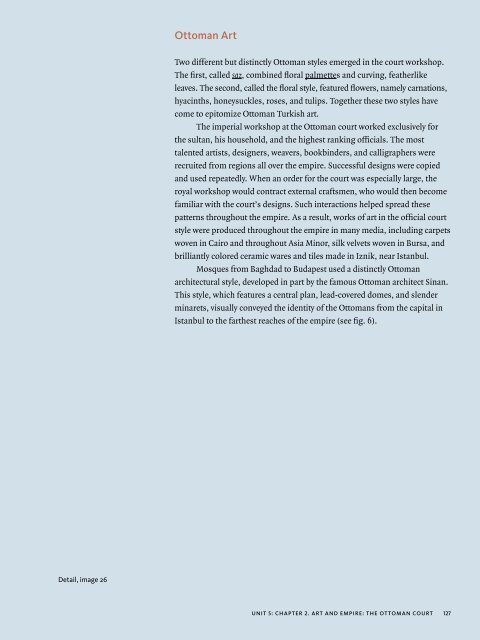Courtly Splendor in the Islamic World - The Metropolitan Museum of ...
Courtly Splendor in the Islamic World - The Metropolitan Museum of ...
Courtly Splendor in the Islamic World - The Metropolitan Museum of ...
Create successful ePaper yourself
Turn your PDF publications into a flip-book with our unique Google optimized e-Paper software.
Detail, image 26<br />
ottoman art<br />
Two different but dist<strong>in</strong>ctly Ottoman styles emerged <strong>in</strong> <strong>the</strong> court workshop.<br />
<strong>The</strong> first, called saz, comb<strong>in</strong>ed floral palmettes and curv<strong>in</strong>g, fea<strong>the</strong>rlike<br />
leaves. <strong>The</strong> second, called <strong>the</strong> floral style, featured flowers, namely carnations,<br />
hyac<strong>in</strong>ths, honeysuckles, roses, and tulips. Toge<strong>the</strong>r <strong>the</strong>se two styles have<br />
come to epitomize Ottoman Turkish art.<br />
<strong>The</strong> imperial workshop at <strong>the</strong> Ottoman court worked exclusively for<br />
<strong>the</strong> sultan, his household, and <strong>the</strong> highest rank<strong>in</strong>g <strong>of</strong>ficials. <strong>The</strong> most<br />
talented artists, designers, weavers, bookb<strong>in</strong>ders, and calligraphers were<br />
recruited from regions all over <strong>the</strong> empire. Successful designs were copied<br />
and used repeatedly. When an order for <strong>the</strong> court was especially large, <strong>the</strong><br />
royal workshop would contract external craftsmen, who would <strong>the</strong>n become<br />
familiar with <strong>the</strong> court’s designs. Such <strong>in</strong>teractions helped spread <strong>the</strong>se<br />
patterns throughout <strong>the</strong> empire. As a result, works <strong>of</strong> art <strong>in</strong> <strong>the</strong> <strong>of</strong>ficial court<br />
style were produced throughout <strong>the</strong> empire <strong>in</strong> many media, <strong>in</strong>clud<strong>in</strong>g carpets<br />
woven <strong>in</strong> Cairo and throughout Asia M<strong>in</strong>or, silk velvets woven <strong>in</strong> Bursa, and<br />
brilliantly colored ceramic wares and tiles made <strong>in</strong> Iznik, near Istanbul.<br />
Mosques from Baghdad to Budapest used a dist<strong>in</strong>ctly Ottoman<br />
architectural style, developed <strong>in</strong> part by <strong>the</strong> famous Ottoman architect S<strong>in</strong>an.<br />
This style, which features a central plan, lead-covered domes, and slender<br />
m<strong>in</strong>arets, visually conveyed <strong>the</strong> identity <strong>of</strong> <strong>the</strong> Ottomans from <strong>the</strong> capital <strong>in</strong><br />
Istanbul to <strong>the</strong> far<strong>the</strong>st reaches <strong>of</strong> <strong>the</strong> empire (see fig. 6).<br />
unit 5: chapter 2. art and empire: <strong>the</strong> ottoman court<br />
127

















